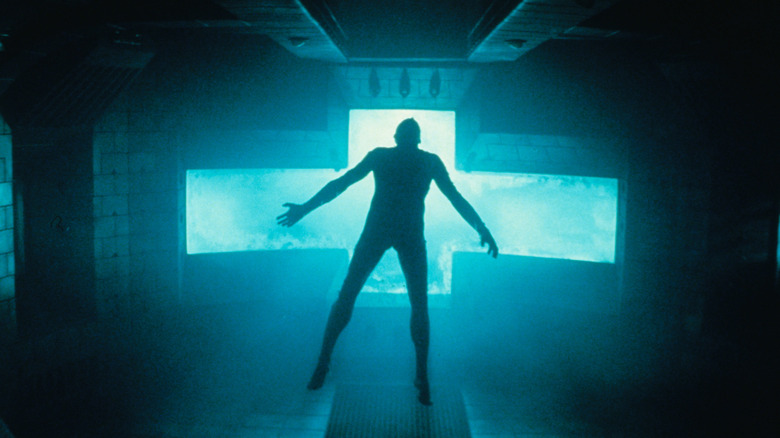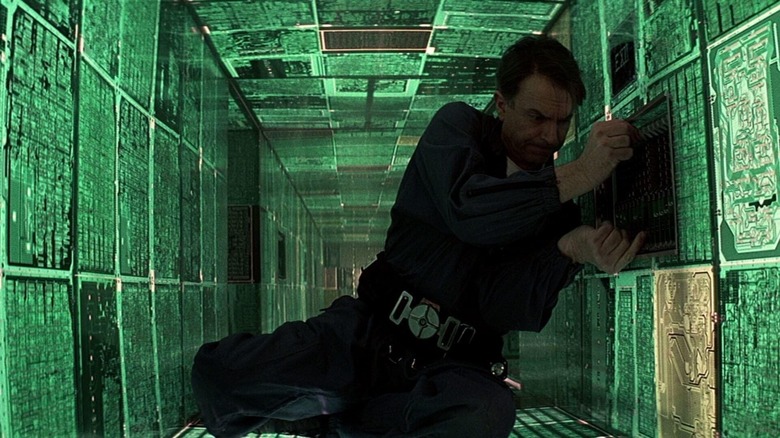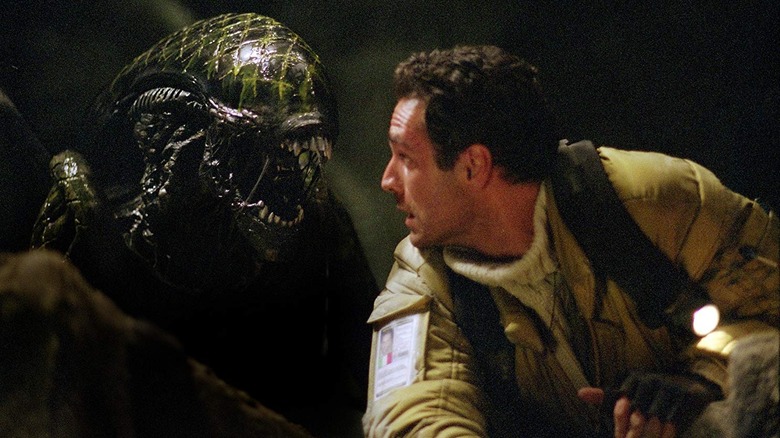Paul W.S. Anderson Didn't Want Event Horizon To Follow In The Footsteps Of Alien
Paul W.S. Anderson's 1997 film "Event Horizon" might belong to a subgenre one might call "high-octane horror." While filled with gruesome images of mutilation and terror, and possessed of demonic, apocalyptic underpinnings, "Event Horizon" has the steely look and mad-dash pace of an action thriller.
The premise of "Event Horizon" is certainly fun. In the near future, scientists have made a ship, called the Event Horizon, that can travel faster than light by popping into another dimension and then popping out again in a new location. Upon its first voyage, the Event Horizon vanished, only to reemerge years later in deep space, out near Neptune. A salvage teams treks to Neptune to investigate, and finds that the previous crew had gone mad, and that the ship has been creatively painted with their innards. It seems the Event Horizon didn't just pop into some random dimension on its sojourn, but into Hell. The ship has returned, tainted by evil. The investigating crew must now fight off malevolent, hypnotic pan-dimensional energies that want to kill or possess them.
Despite a lot of fun, goopy images and an impressive cast (Laurence Fishburne, Kathleen Quinlan, and Sam Neill), "Event Horizon" was a box office failure in 1997, and most critics were unkind. Over the years, however, a cult audience began to grow around the film, to the point that the Shout! Factory has put out an impressive and extensive Blu-ray addition that will satisfy any fanatic.
In an IndieWire interview, conducted in celebration of the film's 25th anniversary, Anderson talked about making "Event Horizon," and how he had to go a great distance to distinguish his "horror movie set on a space ship" from another, popular "horror movie set on a space ship" from 18 years previous.
Definitely not 'Alien'
It's worth noting that Ridley Scott's 1979 sci-fi horror film "Alien" is probably one of the more ripped-off movies in history. All space-bound horror movies that followed it certainly own "Alien" a debt. Even in the 1990s, films like "Screamers" and "Species" were following in its traditions. Anderson was well aware of the long tradition of "Alien" knock-offs, and didn't want his film to draw associations. It certainly helps that "Event Horizon" features no monsters, nor are there many predictable sequences with lone characters wandering off into dark hallways, only to be eaten alive by a mutant hellbeast from space. In "Event Horizon," they are more often stalked by their guilty consciences.
Anderson was clear, saying:
"I didn't want 'Event Horizon' to be an 'Alien' wannabe or a ripoff. I felt that the way avoid that was to make it a Gothic movie and to base it on one of the best pieces of Gothic architecture in the world, the Notre Dame Cathedral in Paris. So we scanned the cathedral into a computer, broke it apart, and then built all the constituent elements of the Event Horizon ship from Notre Dame."
Anderson wisely eschewed the "organic" spaceship designs of H.R. Giger as seen in Scott's film, opting for a corrugated, industrial space that looks more like a factory or a submarine rather than a bizarre alien craft. The Event Horizon itself is, when seen from above, cross-shaped just like Notre Dame, only with antennae clusters instead of gargoyles. Overall, amidst the explosions and gore and mayhem, "Event Horizon" is about cosmic and existential dread. But, as stated, presented in a high-octane fashion.
Alien vs. Predator
While Anderson was careful to stay away from "Alien" during "Event Horizon," he would later embrace Scott's film in the PG-13-rated 2004 B-picture "AVP: Alien vs. Predator." In that film, the creatures from "Alien" are locked in an automatically-shifting mazelike Mayan temple (it's one of those movies) with the creatures from John McTiernan's 1987 film "Predator." If one looks closely, one might note that "AVP" also features several human characters. That film was largely an excuse for slimy creature mayhem, and on a very basic level, it certainly delivers.
Even then, Anderson realized that working with monsters was a delicate affair, and that even "Alien" was wise enough to underplay the fact that the central monster was a human actor in an elaborate costume. It was important to Anderson to keep his camera on scared human faces so that the audience believed in the fear, not the effects. He said:
"[T]he reality of the two deadliest creatures in the universe is that they're guys in rubber suits who can barely stand up and can't see where they're going. They're not terrifying at all. In the first 'Alien,' what sells that it's a terrifying creature rather than a man in a rubber suit is Sigourney Weaver's reaction. She made you believe the horror. [That was an] important lesson for me. Nothing scares an audience more than their own imagination."
One might say that Anderson has become an expert in eschewing "Alien." That, one must admit, is no small feat.


